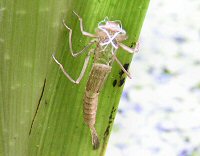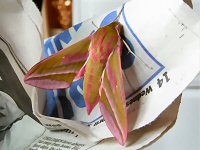Two episodes of insect metamorphoses have both surprised and fascinated me over the last couple of days.
 The empty carapace of a recently emerged damselfly on yellow flag.
The empty carapace of a recently emerged damselfly on yellow flag.
As I reported on
27th April I have regularly seen lots of damselfly nymphs in my pond this year and I have been anticipating a good 'crop'! Yesterday evening I noticed an empty nymph carapace on the stem of a yellow flag (
Iris pseudacorus) and when I took a closer look, I saw several others. Moving around the pond I counted over 30. I had not previously seen any this year and I'm pretty convinced that these damselflies have all emerged together over the last few days. All the empty carapaces were between 2 and 5 centimetres from the water and nearly always on a relatively smooth plant stem. Around a single stem of greater spearwort (
Ranunculus lingua) I counted five empty carapaces with no space between them! Most were dark in colouration with fewer light ones (like the one shown in the picture).
 An elephant hawkmoth; recently emerged from a chrysalis which I found in my garden.
An elephant hawkmoth; recently emerged from a chrysalis which I found in my garden.
Coincidentally also on
27th April I reported finding a large chrysalis on a path adjacent to a flower border in my front garden. I kept the chrysalis amongst some newspaper in a covered fish-tank (without the water!). When I took a look today I was delighted to find that an elephant hawkmoth (
Deilephila elpenor) had emerged from it. I have never seen one in the garden, so this was quite a surprise to me. It made me realise how little I know about the moth fauna of my garden - I will have to do something about that. After taking the pictures, I released the moth into the garden. After a short while it began 'shivering' its wings to warm up the flight muscles and then took its maiden flight. I hope I see more of them.
While we are on the subject of the
27th April, I have since identified the mystery wasp as a german wasp (
Vespula germanica). You can tell by the unbroken yellow band (the gena) on the side of the head behind the eye: the gena of the common wasp (
Vespula vulgaris) is yellow interrupted by black.